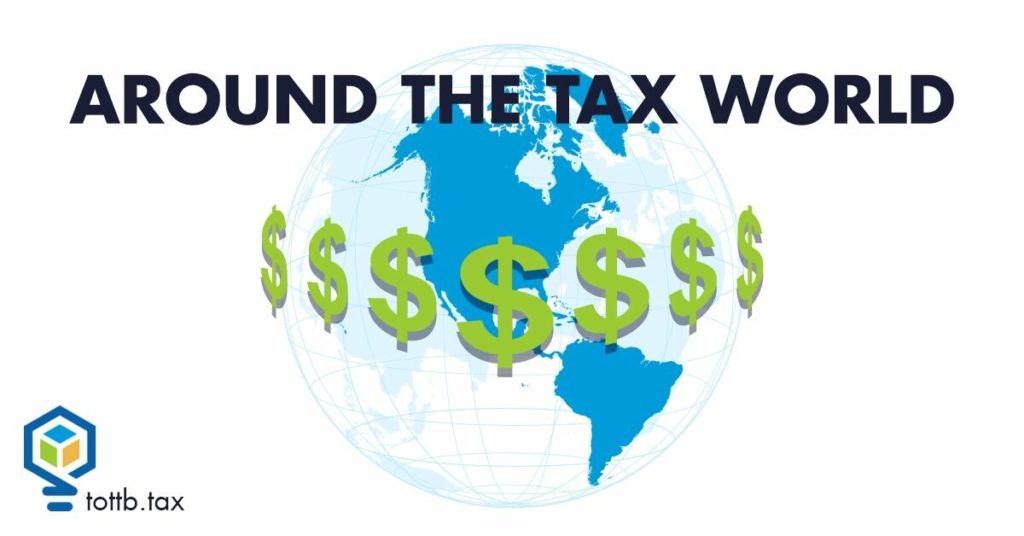
At Around the Tax World, you can find out all about what’s going on in the wonderful, worldwide world of tax. Every month, we’ll feature a few mini-articles on what’s been going on in the world when it comes to tax, and fully available for viewing even if you don’t have a subscription.
If you wish to subscribe and gain access to all articles on the site, be sure to check out the benefits of doing so here!
Check out what’s happening all around the world of tax!
In The Headlines
- Starbucks wants to win you back—with simpler menu offerings and lower prices. New CEO Brian Niccol recently announced a number of upcoming changes, including faster turnarounds for drinks, no extra charge for non-dairy milks, the return of the condiment bar, and store redesigns. In-store customers can expect to see more comfortable furniture and ceramic mugs in the coming months. Niccol will also be nixing many of the customization options currently available, such as olive-oil coffee and toffee nut syrup. The goal? A revival of the days when Starbucks was the cool spot to grab a cup of coffee. Sales have been plummeting month after month for the coffeehouse chain, and the third quarter this year was the worst the company has seen since the pandemic.
- Comcast may dive deeper into the world of online streaming. The cable TV provider is owned by NBCUniversal, which also owns the streaming service Peacock. Peacock is continuing to operate at a loss, although the gap is down to $436 million from $565 million in the previous quarter. In an attempt to stay competitive, Comcast is weighing a partnership with another streaming service. Contenders include Paramount+ and Max (owned by Warner Bros. Discovery). The media giant has also been considering spinning off some of its networks into a separate company. This new entity would likely include Bravo, CNBC, MSNBC, Syfy, and USA Network. Such a change could make life complicated for some of these channels, since MSNBC and CNBC are integrated into NBC News and Bravo has popular programs on Peacock.
- 2024 is a mixed bag for Microsoft as it goes from raking in the revenue to seeing its stock hit a two-year low. In its almost 50 years of existence, Microsoft had never seen earnings as high as it saw in the third quarter of 2024. In those three months, the tech company brought in $65.6 billion, beating the previous quarter’s record $64.7 billion. Meanwhile, Microsoft’s AI offerings continued to take off as public cloud computing platform Azure grew by 34% year-over-year. However, shortly after setting this record, Microsoft shares dipped 6%, marking its worst day since October 2022. The tech giant lost a whopping $175 billion in market capitalization—an amount equal to Disney’s total valuation, for reference.
What's New In The Tax World?
Is the elimination of federal income tax a real possibility?
In the latter days of his campaign, Republican candidate Donald Trump suggested that his proposal of implementing tariffs would pave the way for eliminating federal income tax altogether. This continued the trend of tax-related policies forming a central part of both candidates’ platforms. Previously, Trump had also suggested eliminating taxes on car loan payments, Social Security benefits, and tips for service and hospitality workers.
So why all the focus on tariffs—and how exactly do they work? Tariffs are essentially taxes placed on imported goods. Foreign companies would have to pay the U.S. government to sell their products domestically—an additional cost that is passed onto the consumer in the form of higher retail prices. The aim is typically to keep manufacturing jobs local and make pricing for U.S.-made goods more competitive.
One caution from critics of an “all-tariff” plan is that tariffs can disproportionately affect some consumers more than others. Opponents say that people who spend a higher percentage of their income on necessities, such as food, clothing, housing, and utilities, would struggle under the increased costs that come with tariffs. In this view, a tariff functions as a consumption tax, at least in the short term. Advocates of the tariff plan argue that over time the tariffs will reduce reliance on imported goods and benefit local businesses.
The remaining question is whether tariffs could eliminate the need for income taxes. Some experts say the answer may be “yes” in the short term and “no” in the long term. If tariffs are intended to reduce reliance on foreign goods, then over time foreign sellers will bring in less revenue in the U.S.—and pay less in tariffs. Less tariffs means less revenue to use on federal spending. On the other hand, the federal income tax system is set up to generate more money over time, as incomes rise.
Individual income tax currently generates about $2.5 trillion each year—half of the federal government’s total revenue. To bring in the same amount of revenue, the U.S. would need to levy a tariff of about 70% on all imported goods. So far in his campaign, Trump has suggested tariffs of between 60% and 100% on Chinese goods and between 10% and 20% on all other imported products. He did not specifically mention the elimination of payroll taxes or corporate income taxes in his proposal, which combined make up another 40% of tax revenue.
State-By-State Updates
- California may up its tax credit offerings to the film and television industry. Governor Gavin Newsom has put forth a proposal to allocate $750 million per year to California’s Film & Television Tax Credit Program, more than doubling the current budget of $330 million. This expansion aims to put California back on top among states offering film incentive programs. The Golden State has been losing out on film and television production spending since the pandemic. Some projects that were unable to secure a tax credit relocated to other states to offset costs. Since it launched in 2009, the tax credit program generated over $26 billion for California’s economy and led to 197,000 jobs.
- Florida voters are befuddled by the food and beverage tax that disappeared. Over 20,000 residents of the Miami Beach area had already voted on Referendum 8 when it was suddenly withdrawn from the November 5th ballot. The ballot question put forth a 1% food and beverage tax on restaurants that serve alcohol and earn over $400,000 a year. City commissioners decided to remove the question, stating that the impact on small businesses could be detrimental. However, other officials opposed the action of removing a proposal from the ballot this late in the game. Revenue from the proposed tax would have gone toward homeless and domestic violence services.
- Chicago mayor Brandon Johnson seeks a solution to a $1 billion budget shortfall. The current proposal on the table is a $300 million property tax hike in 2025 with the goal of balancing next year’s budget. Though Johnson promised not to raise property taxes throughout his campaign, the mayor now states that he sees no other course of action. Failure to make up for the revenue gap would result in major cuts to city jobs and services. A previous attempt to increase the transfer tax on million-dollar homes in order to raise revenue did not move forward. To pass the next budget, the mayor will need 26 votes from the City Council by the end of the year.
- New Hampshire lawmakers battle it out over the state’s interest and dividends tax. Gubernatorial hopefuls spent a lot of energy wooing voters by pitching their ideas for the contentious tax, which began phasing out in 2022 and is on schedule to be eliminated in 2025. The 5% tax applied to distributions, dividends, and interest income from investments that totaled more than $2,400 in one year (or $4,800 for married couples filing jointly). State Democrats have argued that repealing the tax only benefited wealthy taxpayers and have advocated for restoring the tax. Only about 10% of New Hampshire residents paid the interest and dividends tax in 2021 and 52% of that tax revenue came from taxpayers who earned at least $200,000 in interest and dividends income.
Tax Planning Tips
What happens if the Tax Cuts and Jobs Act provisions expire? You can prepare today for the future of your estate. Among its many changes to tax law, TCJA doubled the estate tax exemption, allowing taxpayers to transfer property worth up to $13.61 million (or $27.22 for married couples) to their heirs without incurring a tax. This provision is scheduled to expire at the end of 2025, at which time the exemption will revert to its previous level of $7 million. Any part of your estate beyond that—including bonds, life insurance, mutual funds, real property, and stocks—will be subject to a 40% tax rate.
Two popular strategies for preserving wealth are the spousal lifetime access trust (SLAT) and the grantor retained annuity trust (GRAT). A SLAT allows a taxpayer to turn a gift into a trust that benefits their spouse. The assets are set apart from the estate for tax purposes, but the owner still maintains access to the trust’s income and principal. A GRAT, on the other hand, locks in the current value of your assets and transfers any future increase in value to the beneficiaries at a lower tax rate.
The child tax credit continues to be a key element in political dialogue. In 2021, the credit was expanded as part of the American Rescue Plan Act to give additional relief to lower-income families amid the COVID-19 pandemic. Qualifying taxpayers could receive as much as $3,600 per year per child. After one year, Congress declined to renew the expanded version of the credit, and the credit returned to its previous cap of $2,000 per year per child under age 17. If Congress does not take action before the end of 2025, the credit is scheduled to drop down to $1,000 per child.
However, the child tax credit continued to pop up in presidential campaign promises from both Democrat Kamala Harris and Republican Donald Trump. Democrats discussed the idea of exchanging a tax refund for a direct monthly payment to parents, including those who are unemployed or are not required to file an income tax return. Republicans opposed this plan, expressing concern that this could incentivize parents not to work. Trump did indicate he would consider significantly increasing the credit to as much as $5,000 per child.
NOT A MEMBER YET?

SUBSCRIBE TO GET ALL OF OUR
GREAT ARTICLES AND RESOURCES!
CURRENT EDITION

An Analysis of the OBBBA’s Trump Accounts (Part 1)
The One Big Beautiful Bill Act, signed into law by President Trump on July 4, 2025, added a new tax saving tool for minors, the aptly named Trump Accounts. In this article, I go over the details of the new Trump Accounts. In part II, I will discuss some of the potential tax planning opportunities and pitfalls related to the new accounts.

Student Loans After the OBBBA Part 1: New Rules Every Advisor Needs to Know
Big changes are coming to the student loan world (yet again), and they’re not the kind you can just skim past. The One Big Beautiful Bill Act (OBBBA) has reshaped how much students will be able to borrow, how they’ll repay it, and which programs will qualify for federal aid going forward. For financial and tax professionals, these shifts aren’t just policy updates. They’ll set the stage for how you’ll advise clients for years to come… and could even change the way you manage your own student loans. In Part 1 of our OBBBA student loan series, we break down the nuts and bolts of these new rules to help advisors (and borrowers) get some clarity on the collective question: “Seriously, what’s going on with student loans?”

IRS And Courts Have Wisdom to Offer Startup Businesses
There is a wealth of business wisdom in a fairly unlikely area. All the businesses involved lost money, sometimes enormous sums. The source is the litigation and regulation around Code Section 183 of the Internal Revenue Code – Activities not engaged in for profit. In order to deduct those losses against other income, taxpayers need to convince the IRS or the court that they had an honest objective of making a profit. The determination of whether an activity is carried on for profit is made by reference to objective standards. Is it possible that following those standards might contribute to you being profitable? It’s worth thinking about.
Subscribe to view full, in-depth articles
Lorem ipsum dolor sit amet, consectetur adipiscing elit. Ut elit tellus, luctus nec ullamcorper mattis, pulvinar dapibus leo.

